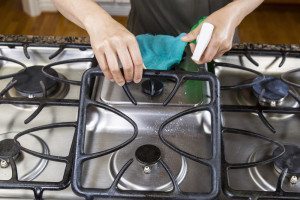Do you have stovetop cleaning challenges? You aren’t alone. One of the most frustrating parts of regular stove maintenance is dealing with cooked-on or baked-on spills. It might be bacon  grease, pasta sauce or bubbling cheese, but regardless, the resulting mess is a headache to clean. The problem occurs whether you have a smooth cooking surface or one with raised burners, whether your stovetop is stainless steel, glass or ceramic. The baked-on crud looks bad and can be hard to remove. Attacking the mess the wrong way can damage your stove, or even void your warranty. Following is a look at how the experts tackle this exasperating kitchen challenge.
grease, pasta sauce or bubbling cheese, but regardless, the resulting mess is a headache to clean. The problem occurs whether you have a smooth cooking surface or one with raised burners, whether your stovetop is stainless steel, glass or ceramic. The baked-on crud looks bad and can be hard to remove. Attacking the mess the wrong way can damage your stove, or even void your warranty. Following is a look at how the experts tackle this exasperating kitchen challenge.
Go Natural
Most stovetops respond well to one of two natural remedies, plus lots of elbow grease. The first is a mix of baking soda and lemon juice or vinegar. You can get rid of much of the spill when it first happens by wiping up what you can with a damp rag. If residue remains, or if it’s an old spill, sprinkle baking soda on the area to fully cover it — baking soda is cheap and nonabrasive, so using a lot won’t cause a problem. Then moisten it with lemon juice or white vinegar — these contain acids that cut through the grease. Leave the mix on your stovetop for at least 15 minutes. If the spill has hardened or if it is very greasy, let it sit for half an hour or longer, then wipe it up with a soft, damp cloth. This should leave a clean and shiny surface and works on glass, ceramic and enamel.
The second natural cleanser is equal parts salt, baking soda and water. Thoroughly mix this paste, apply a small amount to a clean cloth and scrub the spill. If these all-purpose cleaners don’t work, you can try the following specific recommendations for each type of surface.
Glass
Many industry experts recommend microfiber cloths, baking soda and water for spills on glass stovetops. If this doesn’t get the spill off, try buying a cleanser made specifically for glass stovetops. If you have spills that are really hard to remove, like burned sugar, try using Soft Scrub and scraping the spill with the side of a credit card. This won’t scratch the glass surface, but it might be hard on the credit card, so use one that has expired.
Enamel, Porcelain and Ceramic
If the natural baking soda or salt cleaners don’t work, try an oven cleaner sprayed lightly on the spill. Other commercial products that have earned high marks from cooks include Sokoff, Carbon Off, Dawn Power Dissolver and Mr. Clean Kitchen Magic Eraser. For scraping, you can gently use a razor blade, though you risk leaving a permanent mark if you aren’t careful. You can also try the credit card trick, or buy a scraper that is made for glass countertops — these work well on all types of stove surfaces.
Stainless Steel
This material will stain and scratch easily, so you need to treat it gently. Surprisingly, many spills will come off of stainless steel with steam. Fold a paper or microfiber towel and put it over the stain or spill. Pour some boiling water on it and let it set for 10 minutes, then rub the towel over the area gently. If that doesn’t work, pour vinegar on the area and let it sit for 10 minutes. Rub it with a microfiber cloth and rinse. If you still have a problem, pour baking soda on the spill, then vinegar. Rub with a microfiber cloth and rinse.
You can get rid of the crud and keep your stovetop gleaming with elbow grease and a mix of natural products and store-bought cleaners. The other way to keep your stove or range looking great and working perfectly is to have your local appliance repair expert perform regular maintenance. Complete Appliance Repair, serving Woods Cross, Utah, and the surrounding communities, provides a full contingent of appliance sales and repair services, as well as critical periodic maintenance. Contact them today to schedule a service call, and remember to ask your technician for helpful hints for stovetop cleaning and maintenance.

